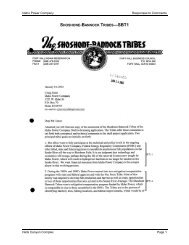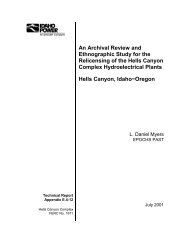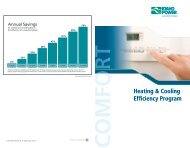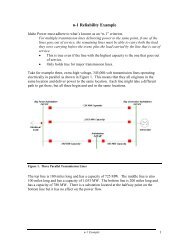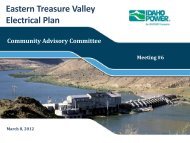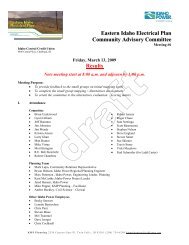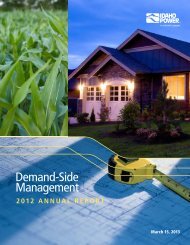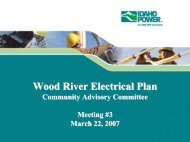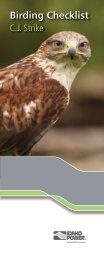Assessment of Chukar and Gray Partridge Populations - Idaho Power
Assessment of Chukar and Gray Partridge Populations - Idaho Power
Assessment of Chukar and Gray Partridge Populations - Idaho Power
- No tags were found...
Create successful ePaper yourself
Turn your PDF publications into a flip-book with our unique Google optimized e-Paper software.
Hells Canyon <strong>Chukar</strong> <strong>and</strong> <strong>Gray</strong> <strong>Partridge</strong> Report, Ratti <strong>and</strong> Giudice 48The only anthropogenic issues that we observed that may be limiting to partridge were(1) the establishment <strong>of</strong> Brownlee, Oxbow, <strong>and</strong> Hell Canyon dams (<strong>and</strong> resulting reservoirs), <strong>and</strong>(2) livestock grazing. In general, we did not detect, nor do we suspect, any significant impactsfrom inundation <strong>of</strong> the Snake River (<strong>and</strong> hydroelectric operations) in Hells Canyon on partridgepopulations or habitat. On 1 occasion we flushed a covey <strong>of</strong> gray partridge near the river edgeon the <strong>Idaho</strong> side <strong>of</strong> Brownlee Reservoir, <strong>and</strong> this covey crossed the reservoir <strong>and</strong> l<strong>and</strong>ed on theOregon side. These birds seemed to have little difficulty with the long flight, even though it wasa relatively wide section <strong>of</strong> reservoir (near the wide bend in the river at approximately mile 318).Thus, we feel certain the reservoirs have not completely restricted regional movements <strong>and</strong> geneflow. This question could easily be examined with a radio telemetry study.Grazing intensity probably has the largest impacts on partridge populations in theCanyon. However, at this time it is not clear what the relationship is between livestock grazing<strong>and</strong> partridge ecology. It seems likely (from our data) that an inverse relationship exists betweengrazing intensity <strong>and</strong> gray partridge distribution <strong>and</strong> density. This relationship is not as apparentwith chukar. We noted high chukar numbers on a few areas that were severely overgrazed;however, chukars were <strong>of</strong>ten in very steep <strong>and</strong> rocky portions <strong>of</strong> habitats that received littlepressure from nearby livestock. However, our bird observations were during fall <strong>and</strong> winter.Spring <strong>and</strong> summer grazing may affect chukar (<strong>and</strong> gray partridge) reproductive success.General habitat conditions <strong>and</strong> vegetative composition are also influenced by grazing intensity.Grazing can influence exotic weed species (see Section 4.10.6.1 above) <strong>and</strong> various grass speciesused by partridge for food, nesting habitat, loafing, <strong>and</strong> escape habitat. Thus, much additionalresearch will be needed to resolve questions on this potential impact on habitat <strong>and</strong> populations.Regardless, we strongly suspect a significant negative relationship exits between grazingintensity <strong>and</strong> partridge ecology, <strong>and</strong> recommend that grazing be considered with regard topartridge management.6.4. Projected future status <strong>of</strong> chukar <strong>and</strong> gray partridge populations<strong>and</strong> habitat quality in Hells Canyon.It is difficult to project the future status <strong>of</strong> any wildlife population, even for species thathave been studied thoroughly. Many factors associated with our changing environment couldeffect partridge populations <strong>and</strong> habitats. For example, use <strong>of</strong> pesticides to control weeds <strong>and</strong>insects that compete for livestock forage may have significant effects on bird populations (e.g.,reproduction). Few toxicology studies on wild populations have been completed, <strong>and</strong> chemicalcompounds change frequently (<strong>of</strong>ten annually). Other factors such as invasion <strong>of</strong> exotic weedsor climate warming could significantly change habitat conditions.However, given the above caveat, the projected long-term status <strong>of</strong> partridge populationsin Hells Canyon appears to be good. This region is very rugged, remote, <strong>and</strong> difficult to developor use for agriculture. In addition, much <strong>of</strong> the l<strong>and</strong> is in protected status, being owned <strong>and</strong>/ormanaged by natural-resource agencies. Hells Canyon is also a popular natural area <strong>and</strong> isheavily used for outdoor recreation. Thus, there likely exists strong public support for protection<strong>of</strong> the natural environment. For the immediate future (5-10 yrs), we are confident that partridgepopulations <strong>and</strong> habitat will remain in good condition.



